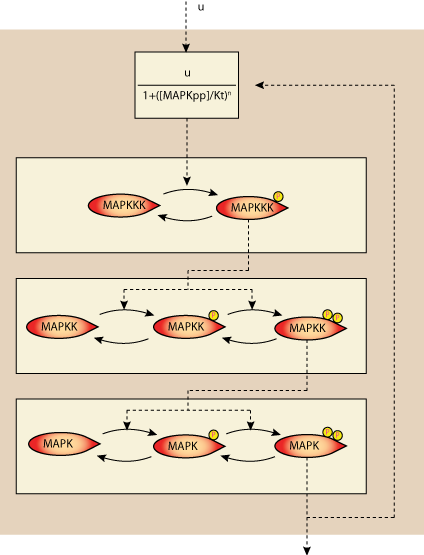Location: Modular Analysis of Signal Transduction Networks @ a8daf3bf5f6a / saez_rodriguez_2004.html
- Author:
- Hanne Nielsen <hnie010@aucklanduni.ac.nz>
- Date:
- 2011-08-23 09:54:25+12:00
- Desc:
- Added HTML file
- Permanent Source URI:
- https://models.physiomeproject.org/w/hnielsen/saez_rodriguez_2004/rawfile/a8daf3bf5f6a7964e04e5cc6a1437430d2d99417/saez_rodriguez_2004.html
Model Status
This CellML model does not run in OpenCell as it is not valid CellML. Some equations seem to be circular
Model Structure
The study of detailed models for intracellular networks has become popular in recent years. New experimental techniques provide significant amounts of data that can be used to develop detailed models of intracellular networks, including signal transduction pathways. In the simplest case, the two-component system, the signaling system consists of two elements: a sensor that detects environmental changes and a regulatory element that influences the transcription of selected genes. In higher cells, however, signal transduction networks involve components that are embedded in feedback loops and interact with each other. The number of elements involved and their complicated nonlinear interactions give rise to a picture of significant complexity. Applying system-theoretic tools to biological systems has attracted increasing interest, leading to the emergence of the field of systems biology [1]. In particular, a decomposition into smaller units or modules, as well as the subsequent analysis of the resulting elements, has been proposed as a useful tool for shedding light on the rationale of signaling networks [2]. How these modules should be defined, however, remains an open question [3]. Furthermore, thorough systems-theory-oriented analyses of signaling networks based on their modularity are still scarce. This article is organized as follows. First, we describe the mechanisms that cells have developed to process information. Second, we discuss the decomposition of signaling networks into subsystems. We then present a novel criterion for defining modules based on the absence of retroactivity [4]. Some simple criteria for the analysis of the resulting units are introduced. Finally, we apply these tools to several examples.
The original paper reference is cited below:
'Modular Analysis of Signal Transduction Networks', Julio Saez-Rodriguez, Andreas Kremling, Holger Conzelmann, Katja Bettenbrock, Ernst Dieter Gilles , 2004 IEEE Control Systems Magazine, 35-52.

|
| Modular representation of the MAPK cascade. |
